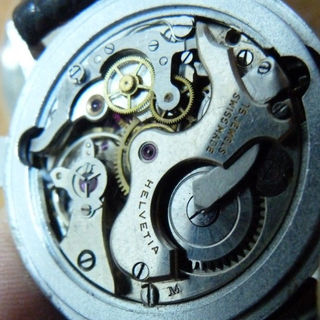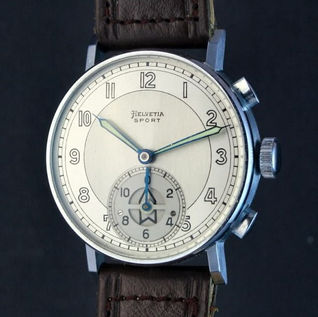
Helvetia 'Stop' and 'Sport'
Chronographs
The Helvetia Stop and Sport were simple but ingenious chronograph wristwatches developed using Helvetia's existing movements during the 1940s.
Scroll down for more.....
Following the introduction of a range of sports, shock protected, watches in 1929 it looks as if Helvetia decided to try to build on this market and develop watches with a built in stop watch function, possibly spurred on by similar watches being developed by other manufacturers at this time.
In 1940 they applied for a patent for a ‘Timepiece with centre seconds hand which can be set to zero’.
This was an adaptation of their 82A movement by the addition of a rocker that acted on the movement to stop and reset the seconds hand when one of two pushers were operated and was designated the 822.
The watch they introduced to utilise this movement was called the Helvetia 'Stop'.

The second hand of the 'Stop' moved constantly, as normal, but could be stopped by the activation of the pusher at 8 o’clock, this disengages the gear train from the seconds hand and stops it. When the button is released the seconds hand is re-engaged and it continues. It can be reset to 12 o’clock by the pusher in the crown at 3 o’clock. Later models had the reset pusher moved to 2 o'clock.
There appear to be two initial case types, both 30mm in diameter. The first has narrow straight 'ladder' style lugs and was given the case number 601. The second case has more standard style lugs but as I have never seen a 'Stop' in one of these cases I don't know what this case number was. When the reset button was moved to the 2 o'clock position new versions of both theses cases were produced, the straight lug version was renumbered to 602 but, again, I don't know what the case number of the newer standard lug version is as the only examples I have seen are military watches and the case number has been removed. Both these 30mm watches had a seconds track around the edge of the dial marked in 5 second increments and came in a variety of styles including luminous dialed versions.
Helvetia 'Stop' Advert From 1941 showing the two initial case types.
HELVETIA Stop
The new watch
with independent centre second hand
General Watch Co
Bienne Switzerland
HELVETIA
The famous old name


1940 Advert for Helvetia Pilots Watches & Stop Chronographs
At the same time, or very shortly after, the 602 case was introduced Helvetia also added a larger, 35mm, cased version. This was numbered the 603. These larger cased watches obviously also had a larger dial and this allowed for the addition of a tachymeter scale to the centre of the dial in addition to the seconds track of the previous watches.
Helvetia also supplied these watches to Orator for their version of the ‘Stop’ and confusingly it looks as if Orator then went on to use the name ‘Stop’ for a range of their watches whether they had second hands that could be stopped and reset or not!
.
.
One other interesting variation of the Helvetia 'Stop' was the British Admiralty Pattern 3169 watch. According to Royal Navy records the Pattern 3169 was designated as a 1/5th second stopwatch, probably for use in naval gunnery, pocket and wristwatch versions were used. Pattern 3169 watches were supplied to the Admiralty by several different manufacturers, one of which was Helvetia, who provided the 'Stop'. On ordering it was specified that the dial and hands be modified so that the time telling functionality was removed and only the stop watch function was visible. The normal case and serial numbers were removed from these watches by the Royal Navy and they were instead marked with the British military property mark of the broad arrow, Patt. 3169 and an individual Royal Navy serial number. Though the serial numbers have been engraved over I have managed to read the remains of enough of one serial number to date these Helvetia Pattern 3169 watches to circa 1941.
As well as applying for the patent for the 822 movement in 1940 Helvetia also applied for another patent for a chronograph watch. In this instance the patent was in regards to having hour and minute chronograph counter hands on the same small subdial. These were the early days of the chronograph wristwatch and there was no convention yet established on what they should look like.

Helvetia obviously had a watch in mind to use this patent and to complement the 'Stop' and allow the timing of events of up to 12 hours in length Helvetia introduced the 'Sport'. This used the same movement as the 'Stop' but with the chronograph function under the dial as opposed to at the back of the watch.
The 'Sport' had both hour and minute counter hands on the same subdial as per the patent (there was no seconds counter), but while it used a standard small 'seconds' type hand for the minute timer it used a larger arrow shaped hand behind it to record the hours, I presume this was to help differentiate the two readings. These counters could again be stopped and reset to zero as in the 'Stop'. The case number for the 'Sport' was 701.
The 'Sport' worked by having the wheels that powered the chronograph recording hands connected to the power of the mainspring via two flat disks that appear to be made of a form of plastic. When in contact with each other they transmitted power to the hands and when separated the hands stopped, working in a similar way to the clutch in a car.
The components that made up the chronograph function were added to the front of the movement via a rectangular plate that could be removed separately.
When the chronograph function is stopped a lever, 1. on the illustration, holds a flat spring, 2. on the illustration, away from the running gear so the two 'clutch' wheels mentioned above separated and no power was transmitted to the chronograph hands. The end of lever 1 also pressed against the hand assembly to stop them moving from the 12 o'clock position due to general movement of the watch in wear.
When the button at 2 o'clock is pressed the lever, 1, moves down and away from under the spring, 2, which allows the spring to apply pressure on the clutch wheels and transmit power to the chronograph hands. At the same time the end of lever 1 moves away from the hand assembly freeing the hands to move.
When the 4 o'clock button is pressed the lever moves back up lifting the spring away from the clutch wheels and the end of the lever resets the chronograph hands to 12 o'clock and remains pressed against them to stop them moving.
By the late 1940s more advanced chronographs had become the norm and the the 'Stop' and 'Sport' were phased out. A short life for an interesting pair of chronographs.
Pattern 3169 Chronograph with thanks to Konrad Knirim. Please check out his excellent books here - Military Timepieces

























